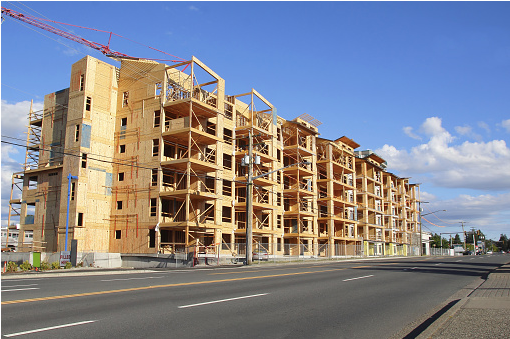Written by William Fitzpatrick
Across Scandinavia and Eastern Europe, a peculiar trend is emerging in recent architectural projects: they are made almost entirely out of wood. But they’re not just any wooden buildings, they’re skyscrapers. In the past, most architectural advancements have been focused on design, but with the climate crisis looming closer by the day, this is an innovation focused on sustainability.
To understand why architects and engineers seem to be reinventing the wheel, it is first important to understand where this trend originated. Matthias Korff, a German developmental director, oversaw and created Europe’s first five story wood building. According to Korff, this was a step toward a greener future. His calculations state that two metric tons of CO2 are saved per cubic meter of wood (Sieg, 2021), a drastic decrease compared to the impact most modern buildings have on the environment. Per CNN, “The construction and operation of buildings accounts for 40% of the world’s energy consumption, and approximately one-third of greenhouse gas emissions” (Holland, 2020). Decreasing the environmental impact of building development has led many progressive countries to subsidize and encourage more wood-based projects. Subsequently, many architecture firms are eager to rise to the occasion and pioneer what appears to be the latest trend in green construction.
Globally, there is little eagerness to adopt the building style. Although many countries with lush forests and ample timber find the idea appealing, cities such as Dubai have little use for the concept. Having used traditional high-rise materials for much of its existence, it would seem impractical to make the shift during a time of slowing development. Similarly, many underdeveloped countries do not benefit from the subsidies, tax benefits, or resources that the United States and Europe do. Because of this, it is unlikely that the trend will gain global traction, as it appears to be a luxury for only those countries with the necessary resources at their disposal. Those countries who can afford it, however, are quickly making strides in the right direction.
In Scandinavia, several exciting projects appear just over the horizon. In Finland, the Jonessu apartment building is made entirely of wood, apart from a slab of concrete between each floor (Holland, 2021). Similar projects have popped up in Norway and Sweden as well. One of the greatest barriers to the construction of wooden high-rises is building code. In many countries, though, this is changing. Many large cities within Germany are adjusting their code, and the United States very recently decided to permit all-wooden high-rises up to 18 stories tall (Elbein, 2020). This crucial change echoes decisions made by the International Building Code, which many countries model. They are set to allow 18 story timber high-rises as well (Holland, 2020). With all of the positives that come with lumber based construction, it is only natural that there has recently been a catch: the COVID pandemic.
In 2020 and 2021, lumber prices across the United States spiked as the demand for houses rose and many people stuck at home tried their hand at DIY renovations. NPR reports that the price of lumber per thousand board feet was $303.4 in March 2020, soaring by a quintuple to $1607.5 by May of that same year (Hernandez, 2021). Unsurprisingly, similar, if not greater price spikes were seen across Europe. With high lumber prices and a stagnating global supply chain, many of these groundbreaking projects have been put on hold. The pandemic has also slowed down research and development of wood based products that will lower construction costs and increase the safety of the wood being used. Even beyond these circumstantial issues, the cost of large wooden buildings remains higher than its concrete counterparts.
Advocates for these wooden constructions say that the ability to prefabricate whole floors or even entire buildings will drastically reduce construction costs and time (Sieg, 2021). In time, they believe that wooden construction will be significantly cheaper and safer, reducing both pollution and on-site chemical exposure. But this reality can only exist if the supply of lumber remains steady, however high the price. Further, a reliable and consistent climate is crucial for reforestation of areas being used for lumber. This is no guarantee, as the very climate change the construction attempts to battle is stealing away the sources of lumber.
Despite the excitement by many to see these wooden projects proliferate, for the time being, it may simply be impractical. High lumber costs, supply chain issues, and the emerging Omicron variant are continually hindering these futuristic projects. Even though many economists are predicting a positive outlook for global shipping, the backlog may take several years to fully work itself out. Although you may not find yourself in a cozy log cabin high-rise next year, you haven’t heard the last of this unusual yet exciting innovation.
Elbein, Saul. “Will the Skyscrapers of the Future Be Made out of Wood?” Science, National Geographic, 4 May 2021, https://www.nationalgeographic.com/science/article/skyscrapers-of-the-future-will-be-made-out-of-wood.
“The Era of the Wood Skyscraper Is Arriving.” Reasons to Be Cheerful, 24 Apr. 2021, https://reasonstobecheerful.world/the-age-of-the-wood-skyscraper-is-arriving/.
Hernandez, Joe. “Lumber Prices Are Finally Dropping After They Soared during the Pandemic.” NPR, NPR, 21 June 2021, https://www.npr.org/2021/06/21/1008843212/lumber-prices-are-finally-dropping-after-they-soared-during-the-pandemic.
Holland, Oscar. “Has The Wooden Skyscraper Revolution Finally Arrived?” CNN, Cable News Network, 13 Feb. 2020, https://www.cnn.com/style/article/wooden-skyscraper-revolution-timber/index.html.

